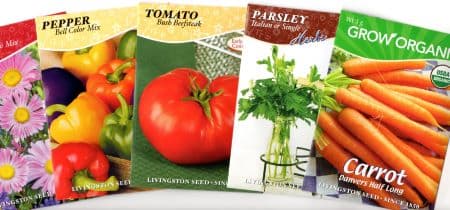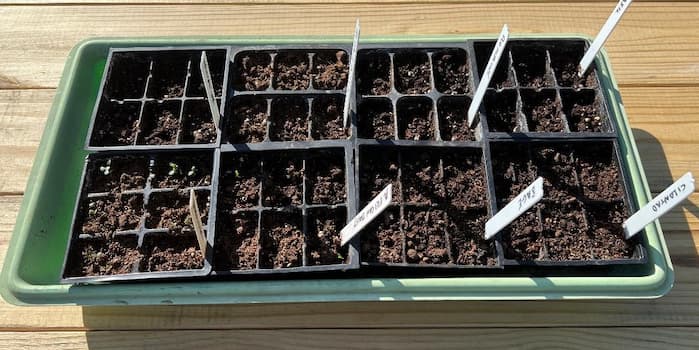All About Garden Seeds

It All Starts with the Seed
Without a doubt, great gardens begin with great garden seeds. Experienced growers will tell you that a good seed, the right seed, is an important first ingredient for a successful crop. Whether it’s a flower, vegetable, herb, or organic seed, a great gardening season begins with the highest quality you can find. Hopefully, the packet in your hand holds the promise of a great gardening season.
The annual seed search begins right after New Year. The search itself is a great winter hobby.
So, let’s get growing!
Selecting Your Garden Seeds
A successful garden begins with great seeds. This means:
The seeds you acquire are viable and will have a good germination rate. A viable seed has fully formed. It is capable of sprouting after sowing. Subsequently, an immature one will not sprout. A seed that has not fully developed is flatter, not the right color, smaller, or feels hollow. Also, they age and decay over time, even in the most ideal situations. Normally, seeds from the prior season’s crop have the best germination rates. Some types have a longer shelf life than others. If properly stored, some they will remain viable for several years. However, the germination rate declines the longer you store them.
Genetics, genetics, genetics. If you want a large pumpkin, obtain seeds from a large parent. If you are seeking red tulips, acquiring bulbs from a red tulip parent is a necessity. For the tallest sunflower, find a tall parent. Read up on the plants and select ones that specifically meet your criteria.
Fellow growers are a great source, especially for uncommon or “Heirloom” strains. These seeds often have unique characteristics not offered by a garden store company.
While searching for the perfect seed, consider your local area’s climate conditions. Look for plant varieties best suited for your area. Some varieties of a given plant will grow better in cool or hot weather than others. This may also influence your selection of varieties with shorter maturity dates.
Plant size is also important. For example, dwarf fruit trees are usually best for home backyards. Space constraints may require varieties of plants with a smaller growth habit. For example, sugar baby watermelons may be the only variety of watermelon you can grow.
- We recommend purchasing from only high-quality companies like Ferry Morse, or Burpee seed companies.

Garden Seed Sources
Paper Catalogs – For many decades, paper catalogs were the starting place for finding all sorts of products. The search began right after the new year. Gardeners sought a cozy easy chair beside a warm fire, with a catalog in one hand and a cup of hot chocolate in the other. Costly paper catalogs have been replaced by online catalogs.
Online Sources – It’s a great place to find uncommon and heirloom varieties. Surf and make your selections from the comfort of your living room. Buy at prices lower than in stores.
Brick and Mortar Stores – Garden stores and the “big box” stores are a good source. They have a supply of popular plant varieties during the growing season. Brick and Mortar stores offer a much more limited selection than online stores. They cater to the masses.
Other Growers – This is an outstanding source. Importantly, you can often receive or swap hard-to-find varieties, that will make your garden stand out from the rest. Wise and avid gardeners cultivate this source from friends, relatives, neighbors, and fellow growers.
Did you know? Many growers believe that plant disease can be spread from seeds. Keep this in mind when acquiring seed from fellow growers. However, don’t let this deter you. Ask about the health of their crops. If they have had recent problems, you may want to decline.
Tip: Looking for some different varieties to grow this year? Try an online chat room. This can work especially well if you have seeds to swap.
Saving Garden Seeds
Here’s how to harvest your garden seed:
Select healthy plants. A seed contains the DNA of the parent plants, just like humans and animals. Consequently, use plants with the “biggest or brightest bloom”, or largest and tastiest fruit”. Also, consider other favorable plant qualities and traits.
Plants appearing more disease resistant are the best candidates.
Gather seeds from two or more plants. Multiple sources increase the likelihood of good seedling germination.
Make sure the seed is mature. This is more difficult than it may seem. For example, a green tomato has immature seeds. Also, a flower seed may not be mature until weeks after the bloom has died back.
Extract them from the flower or fruit.
For seeds picked dry, proceed to step 12.
Wash and rinse them thoroughly using mildly soapy, lukewarm water. Do not use hot water and do not soak them in the water.
Use a strainer to drain them.
Spread them out on an old screen. This allows air circulation.
Stir them at least once a day for the first few days. Turn them over as you stir.
Allow them to air dry in a cool, dry area for three weeks, or longer. Do not cut the drying time short, even if they appear “dry”.
Examine and sort them, discarding any that appear immature or malformed, small, or damaged.
Store them in a bag, or envelope in a cool dry place. Air-tight jars are not recommended. If they are not thoroughly dried, they will mold and rot.
Mark the packet or envelope with the date and type of seed.
Some people place them in a freezer for a couple of weeks, to replicate nature. This is optional for most seeds.
If you grow potatoes, you will find it’s easy to make seed potatoes. See How to Make Seed Potatoes.
Sowing Seeds
There is no trick to the basic process of sowing and planting. Seed packets will normally tell you the proper depth and spacing. Follow those instructions. Our individual plant guides also contain this information.
The most frequent mistake growers make is to plant them too deeply. If they are sown too deep, they may germinate, but be unable to sprout to the surface. The general rule of thumb is “twice the diameter of the seed”. But, who do you know measures their diameter?
From a practical standpoint, make sure to read the instructions on the packet, for the proper planting depth. When in doubt, plant it shallower than the instructions. This is especially true if you have hard, clay soils as it is more difficult for the seedling to emerge. You can always add more soil or mulch around the base of the plant after it germinates.
Indoors: Follow the packet instructions for depth. We recommend always planting a little shallower than the instructions. When planting indoors, there is less risk of the surface of the soil drying out, as it is not exposed to the effects of sun and wind. Leave adequate room in the planting container to add more soil around the stem of your seedlings.
Pre-Soaking Seeds
This is a very common practice. Many seeds can be soaked in water before planting. This allows moisture to penetrate the shell and reach the germ inside. It gives them a germination jump start. Soak them anywhere from a couple of hours to 24 hours before planting. You can also place them between wet paper towels.
In general, pe-soaking works best with larger seeds. There is a risk of ruining smaller ones. So, experiment with small amounts before you devote your entire year’s crop to this method. With paper toweling, use a wet, not soaking wet toweling and leave the seeds inside it. Add bottom heat to speed up the germination process further.
Nicking Seeds
Some people nick the shell with a sharp knife. This creates an avenue for moisture to more readily penetrate to the nut inside, resulting in faster germination.
This practice is limited to larger ones that you can handle. It is also very tedious.
Related Articles
Survival Seed – definition and storage
Please support our site. Shop for:
- rmmatthews100@hotmail.com
- 585-721-6528
- Rochester, NY
©1999-2024 GardenersNet.Com, All Rights Reserved

